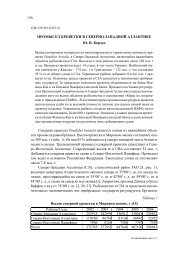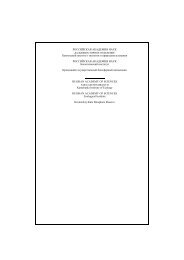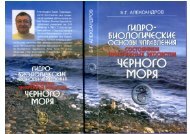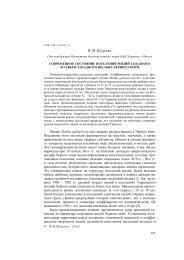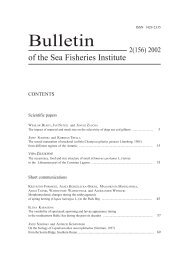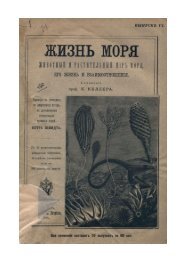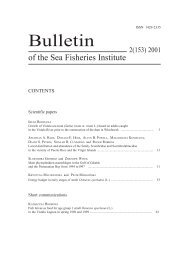Bulletin of the Sea Fisheries Institute 1 (155) 2002 - CEEMaR
Bulletin of the Sea Fisheries Institute 1 (155) 2002 - CEEMaR
Bulletin of the Sea Fisheries Institute 1 (155) 2002 - CEEMaR
Create successful ePaper yourself
Turn your PDF publications into a flip-book with our unique Google optimized e-Paper software.
12<br />
NATALIA KRASOVSKAJA<br />
7<br />
6<br />
A<br />
Salinity, psu<br />
5<br />
4<br />
3<br />
2<br />
Krasn<strong>of</strong>lotskoje<br />
Tolkmicko<br />
Baltiysk strait<br />
1<br />
0<br />
I II III IV V VI VII VIII IX X XI XII<br />
4.5<br />
4<br />
B<br />
3.5<br />
3<br />
2.5<br />
2<br />
1.5<br />
1<br />
1950-1964<br />
1960-1970<br />
1970-1980<br />
1980-1990<br />
1990-2000<br />
0.5<br />
III IV V<br />
Months<br />
Fig. 4. Salinity conditions in <strong>the</strong> Vistula Lagoon. Monthly means for 1950-1964 (Anon 1971) (A)<br />
and inter-annual changes in spring by decades (B).<br />
Inter annual variability <strong>of</strong> spawning in relation to environmental conditions<br />
and <strong>the</strong> state <strong>of</strong> stocks<br />
The timing and duration <strong>of</strong> herring spawning and <strong>the</strong> hydrological conditions in <strong>the</strong> Vistula<br />
Lagoon are remarkably variable (Table 2). Range <strong>of</strong> variables, standard deviation values and<br />
coefficients <strong>of</strong> variation are presented in Table 3. The presence <strong>of</strong> herring schools in <strong>the</strong> lagoon<br />
varied from 34 to 104 days throughout <strong>the</strong> period under consideration. The spawning event<br />
extends from February 12 to June 25 in different years (March 24-May 27, on average). Within<br />
this period, spawning and mass spawning can take place during 57 (28-90) and 35 (13-63)<br />
days, respectively. The difference in <strong>the</strong> spawning season exceeds two months from year to<br />
year with April 25 being <strong>the</strong> boundary between <strong>the</strong> end <strong>of</strong> <strong>the</strong> earliest spawning and onset <strong>of</strong> <strong>the</strong><br />
latest one. Mean water temperature within <strong>the</strong> spawning period varied from 7.7 to 14.1°C and<br />
can rise ra<strong>the</strong>r quickly from about 1°C when <strong>the</strong> first herring enter <strong>the</strong> lagoon to more than<br />
19°C during <strong>the</strong> last spawning waves. It should be noted that Baltic herring are very tolerant to<br />
low salinity. In <strong>the</strong> Vistula Lagoon, herring spawn at a value <strong>of</strong> 1.23-4.93 psu. The data presented<br />
are characterized by high CV, in <strong>the</strong> range <strong>of</strong> 11.6-38.7%, with minimum values at <strong>the</strong> end <strong>of</strong><br />
<strong>the</strong> herring spawning period (Table 3). Water temperature and salinity as well as <strong>the</strong> time when<br />
<strong>the</strong> first herring entered <strong>the</strong> lagoon had a significant impact on <strong>the</strong> timing and duration <strong>of</strong><br />
spawning (Table 4).



